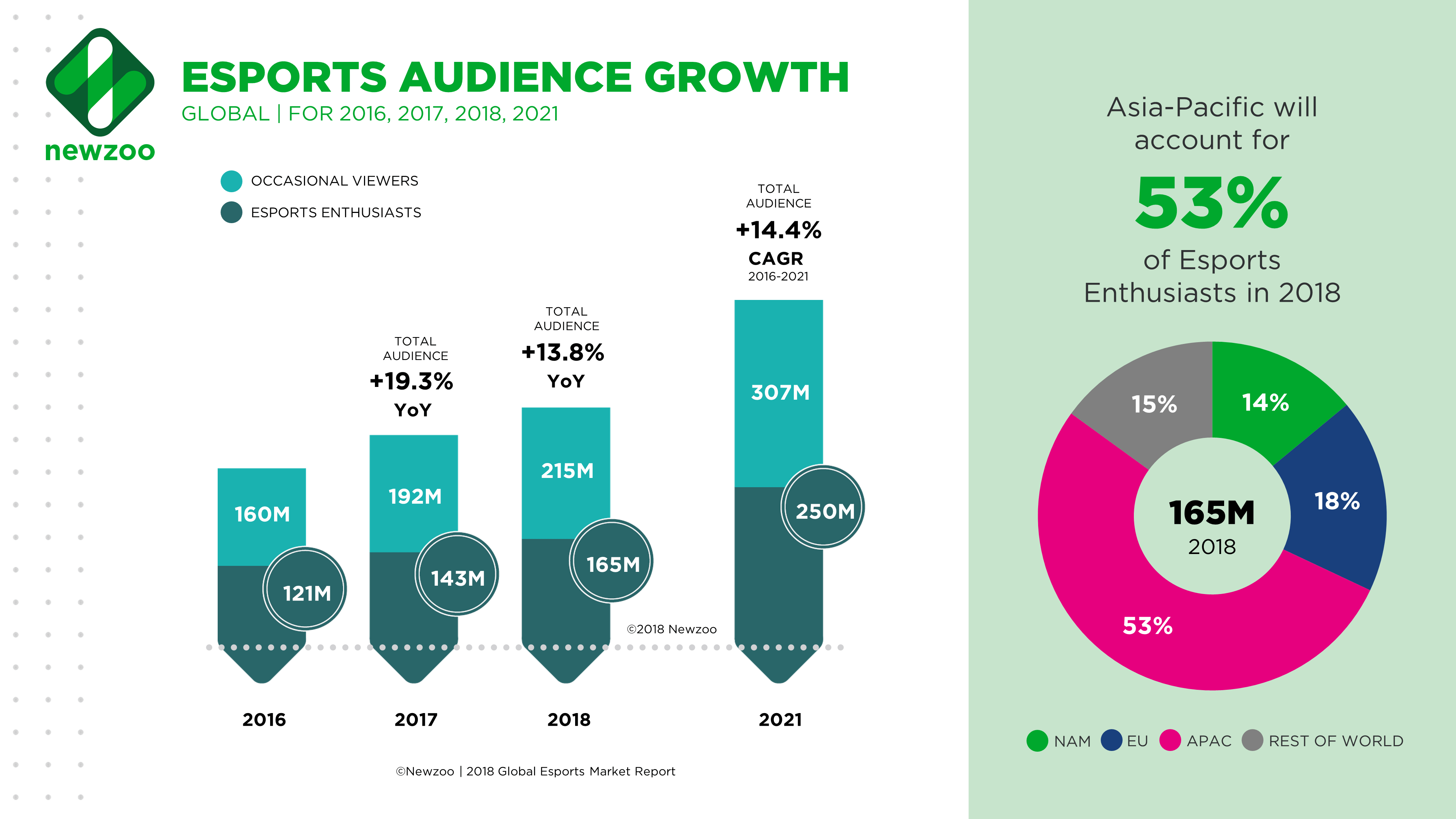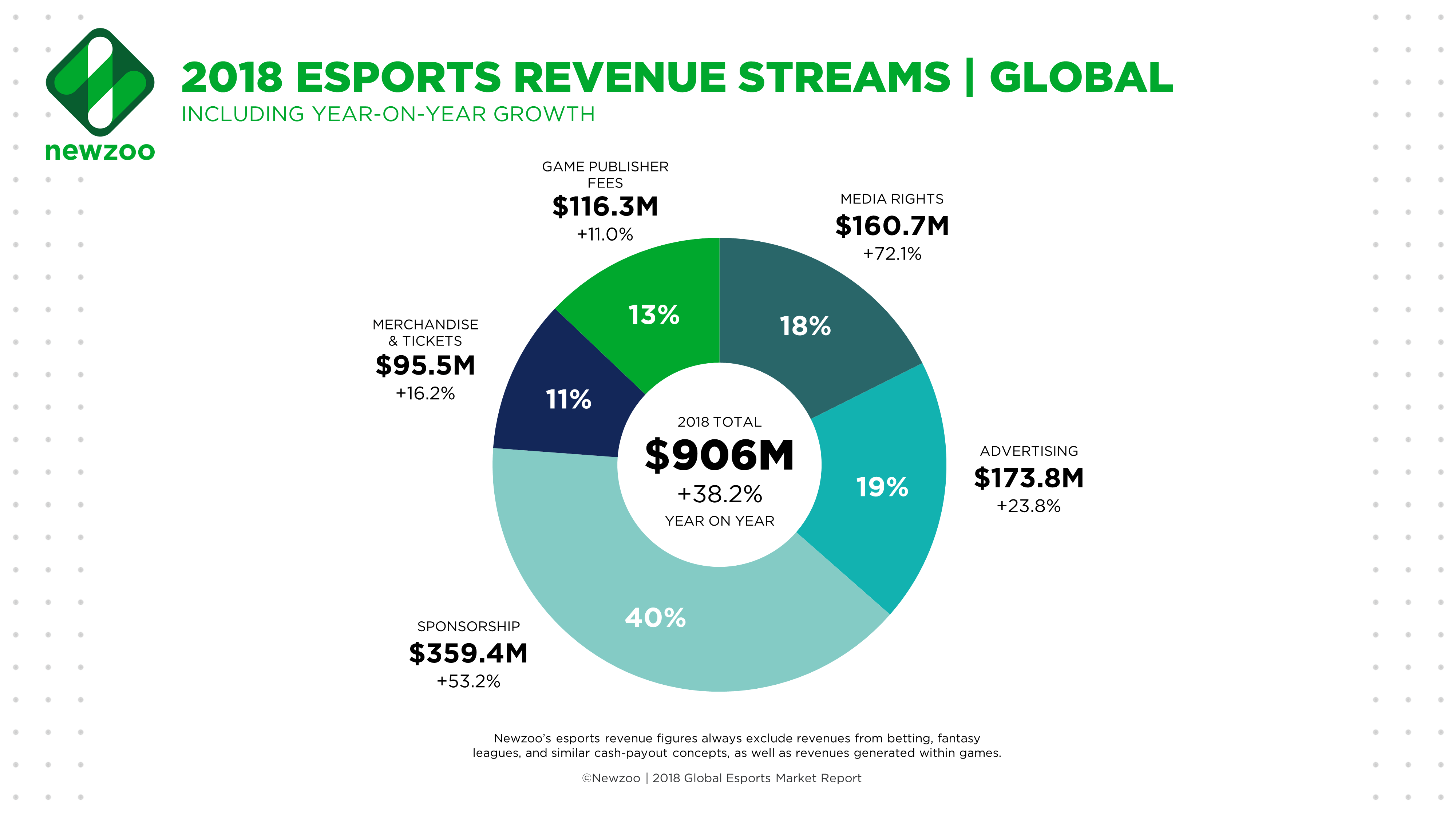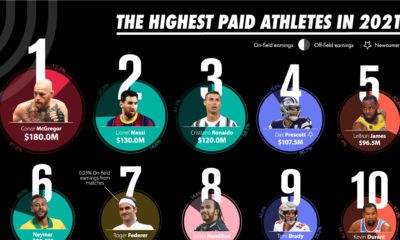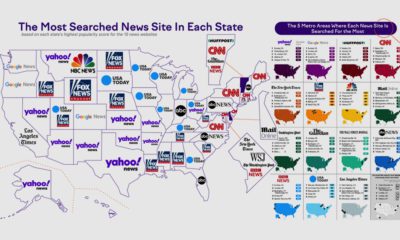People tune in from all over to see these athletes in peak form, and tournaments rake in cash from media rights, advertisements, sponsorships, merchandise, and also the live event itself. In turn, these competitions offer millions of dollars in prize pools for the participants. But what if there was a new type of sport that upped the ante? While sport purists might scoff at the idea of any type of competition involving video games – the numbers speak for themselves. The realm of eSports already has tournaments that pack stadiums, offering bigger prize pools than either the Tour de France or The Masters. And soon, eSports will be a billion dollar business with a global audience of over 300 million fans.
The Booming Business of eSports
Today’s infographic comes to us from Moneypod, and it dives right into the interesting and possibly unfamiliar arena of eSports, which is seeing double-digit growth in all revenue categories from media rights to merchandise sales.
Gaming has always been popular, but the rise of eSports is something new. The excitement around these competitions pairs the popularity of gaming with changing demographics, growing buying power for consumers in Asia (where the sport is the most popular), increased levels of connectivity, and new technological advancements. Perhaps even more interesting is that the business of eSports is flourishing as a result – and with packed stadiums, deals with media giants like ESPN, double-digit revenue growth rates, and hundreds of millions of fans, it has been said that this is the year that eSports hits the mainstream.
Latest Market Projections
In the last few months, new market projections on the business of eSports have come out from NewZoo, a market intelligence company focused on games, eSports, and mobile. Here are their latest projections for audience growth:
There are 215 million fans today, including 165 million hardcore enthusiasts. The majority of this group, about 53%, resides in the Asia-Pacific region. Lastly, here is a breakdown of projected revenue streams for 2018: Impressively, media rights is the fastest growing segment at 72.1% growth. The sponsorship segment isn’t far behind at a 53.2% growth rate. In total, the market is expected to be worth $906 million this year, a solid 38.2% higher than in 2017. This expansion is not expected to stop anytime soon, and in 2019 eSports will be a market in excess of $1 billion in size – a figure that will surely put this emerging space in an even bigger spotlight.
on But fast forward to the end of last week, and SVB was shuttered by regulators after a panic-induced bank run. So, how exactly did this happen? We dig in below.
Road to a Bank Run
SVB and its customers generally thrived during the low interest rate era, but as rates rose, SVB found itself more exposed to risk than a typical bank. Even so, at the end of 2022, the bank’s balance sheet showed no cause for alarm.
As well, the bank was viewed positively in a number of places. Most Wall Street analyst ratings were overwhelmingly positive on the bank’s stock, and Forbes had just added the bank to its Financial All-Stars list. Outward signs of trouble emerged on Wednesday, March 8th, when SVB surprised investors with news that the bank needed to raise more than $2 billion to shore up its balance sheet. The reaction from prominent venture capitalists was not positive, with Coatue Management, Union Square Ventures, and Peter Thiel’s Founders Fund moving to limit exposure to the 40-year-old bank. The influence of these firms is believed to have added fuel to the fire, and a bank run ensued. Also influencing decision making was the fact that SVB had the highest percentage of uninsured domestic deposits of all big banks. These totaled nearly $152 billion, or about 97% of all deposits. By the end of the day, customers had tried to withdraw $42 billion in deposits.
What Triggered the SVB Collapse?
While the collapse of SVB took place over the course of 44 hours, its roots trace back to the early pandemic years. In 2021, U.S. venture capital-backed companies raised a record $330 billion—double the amount seen in 2020. At the time, interest rates were at rock-bottom levels to help buoy the economy. Matt Levine sums up the situation well: “When interest rates are low everywhere, a dollar in 20 years is about as good as a dollar today, so a startup whose business model is “we will lose money for a decade building artificial intelligence, and then rake in lots of money in the far future” sounds pretty good. When interest rates are higher, a dollar today is better than a dollar tomorrow, so investors want cash flows. When interest rates were low for a long time, and suddenly become high, all the money that was rushing to your customers is suddenly cut off.” Source: Pitchbook Why is this important? During this time, SVB received billions of dollars from these venture-backed clients. In one year alone, their deposits increased 100%. They took these funds and invested them in longer-term bonds. As a result, this created a dangerous trap as the company expected rates would remain low. During this time, SVB invested in bonds at the top of the market. As interest rates rose higher and bond prices declined, SVB started taking major losses on their long-term bond holdings.
Losses Fueling a Liquidity Crunch
When SVB reported its fourth quarter results in early 2023, Moody’s Investor Service, a credit rating agency took notice. In early March, it said that SVB was at high risk for a downgrade due to its significant unrealized losses. In response, SVB looked to sell $2 billion of its investments at a loss to help boost liquidity for its struggling balance sheet. Soon, more hedge funds and venture investors realized SVB could be on thin ice. Depositors withdrew funds in droves, spurring a liquidity squeeze and prompting California regulators and the FDIC to step in and shut down the bank.
What Happens Now?
While much of SVB’s activity was focused on the tech sector, the bank’s shocking collapse has rattled a financial sector that is already on edge.
The four biggest U.S. banks lost a combined $52 billion the day before the SVB collapse. On Friday, other banking stocks saw double-digit drops, including Signature Bank (-23%), First Republic (-15%), and Silvergate Capital (-11%).
Source: Morningstar Direct. *Represents March 9 data, trading halted on March 10.
When the dust settles, it’s hard to predict the ripple effects that will emerge from this dramatic event. For investors, the Secretary of the Treasury Janet Yellen announced confidence in the banking system remaining resilient, noting that regulators have the proper tools in response to the issue.
But others have seen trouble brewing as far back as 2020 (or earlier) when commercial banking assets were skyrocketing and banks were buying bonds when rates were low.
















